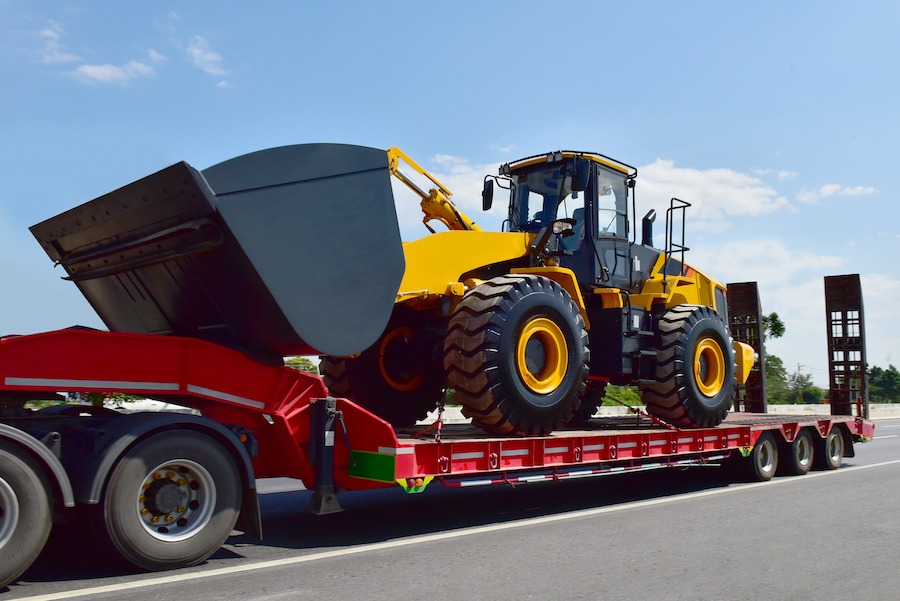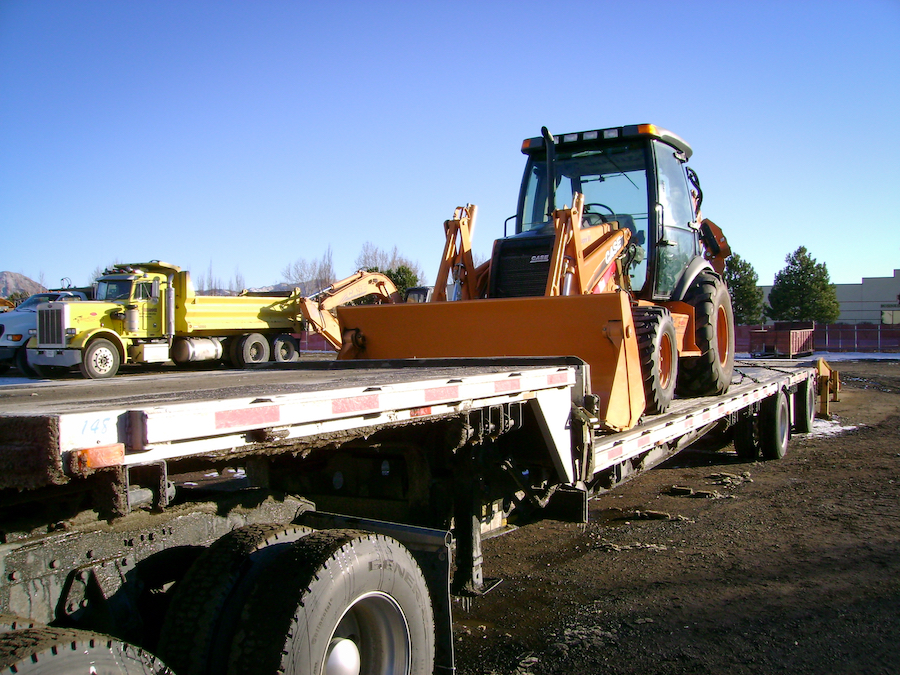View the complete article here
Heavy hauling is hard work. Not just the part where you have to somehow get a huge hunk of machinery onto a transport vehicle. The logistics and legal know-how you need to properly haul stuff from one place to another can be pretty intense. The larger the load – the bigger the headache. In this article we discuss common pitfalls of heavy hauling. No worries – we’re also going to give you some great tips on how to do heavy hauling the right way.
Heavy Hauling Pitfalls
There are many pitfalls you may encounter when heavy hauling. Let’s dive into some of the more common pitfalls.
Not Accurately Measuring Your Heavy Haul
The first decision you need to make is what kind of transport vehicle is needed for your heavy haul. It’s not like you can just whip out the tape measure and postal scale for a huge piece of construction equipment. Also some machinery and materials are oddly shaped. The planning for the heavy haul begins with accurately measuring your cargo. You need to determine the weight as well as the length, width, and height. Be sure to include whatever you use to secure the load, such as tie downs and chains.

Not Inspecting the Load
Another common pitfall is not double (or triple) checking the load. You must carefully inspect the load before the heavy hauler fires up the transport vehicle.
Not Inspecting the Transport Vehicle
You also need to inspect the transport vehicle. All that weight can wear a truck and trailer down. A carefully tied-down load will hit the bricks if the transport vehicle’s tires fail.
Not Getting Proper Permits
Permits are not just revenue enhancers for state and local government agencies. It’s how you let local authorities know that you’re going to be driving around in a big transport vehicle with a giant load that could pose a danger to their citizens. Not knowing – and following – their rules and regulations is a huge pitfall. Instead of reaching your destination you may find yourself stopping off at the courthouse to pay a big fine.
Driving Too Fast
Driving too fast is an all-too-common pitfall. You’re in a transport vehicle – not a race car. Drive like you’re taking Grandma to church. In this case Grandma weighs many tons and is precariously perched on a trailer bed. Careless driving is more than a pitfall. Lives are at stake. The National Highway Transportation Safety Administration (NHTSA) reports that in 2019, there were 5,005 fatal crashes involving large trucks (those with a gross weight of 10,000 pounds are more). 3,016 – about 60% — involved tractor-trailers.
Not Knowing the State’s Laws
We know – you’ve hauled heavy stuff in California, Wisconsin, and Idaho. But now you’re in North Carolina. Maybe the heavy hauling laws are the same. Maybe not. A huge heavy haul pitfall is assuming that what flies in one state is going to be totally cool in another. Here’s one example: In Idaho an oversized permit is good for 5 days and you can travel any day 30 minutes before sunrise and 30 minutes after sunset. In North Carolina the permit is good for 10 days, but you cannot travel on any given Sunday.
Not Traveling the Route in Advance
Another heavy haul pitfall is not driving the route you’ve mapped out in advance. How the route looks on a map may be very different in real life. Or maybe you did remember to drive the route – a couple of weeks ago. Check it out again a day or two before the haul date, if at all possible. You want to identify any impediments to the transport vehicle – like low overpasses – in advance. You definitely do not want the transport driver to discover these problems up close and personal.

Not Mapping an Alternate Route
Traveling the route in advance is a great way to reduce risk. But things happen. Like all the time. Another heavy haul pitfall is not planning out an alternative route for your transport driver.
Not Staying in Touch with the Driver
Your transport driver can run into trouble on the road. They should be able to easily reach you or someone on your team. You want to be the one who makes any needed “executive” decisions. Not staying in touch with the transport driver is a pitfall that is easily avoided. Before they hit the road, double check that they have the team’s contact info readily available.
Not Checking In
A huge heavy haul pitfall is not checking in and inspecting the load throughout the transport. It’s not enough to make sure the load is tied down properly before the transport vehicle starts moving. The moving of the transport vehicle can shift the load.
Not Being Flashy
We’re not talking about wearing a studded leather jacket and snakeskin boots. Cool, but not flashy enough for other drivers to know you’re there. This heavy haul pitfall involves thinking that a large transport vehicle with a crane on top of it is obvious enough. But to regular commuters drinking coffee and talking on their phones while changing lanes, it isn’t. Flashers, flags, banners, and an escort vehicle may be needed (or required by law) to get their attention.
Not Being Prepared for Takeoff
We know you spent a lot of time and energy getting your heavy haul to the job site. You’re tired. Well that’s too bad because a huge heavy haul pitfall is not being prepared to take the load off the transport vehicle. There’s more to unloading than undoing the tie downs and taking off the cargo. We’ll talk about this more in our list of heavy haul tips.
Not Wearing Proper PPE
Worn out or cheap boots just don’t cut it on a heavy haul job. Wear the hard hat and the vest with the shiny orange stuff all over it. A solid pair of gloves will keep your hand model career alive. And safety glasses will keep your peepers pretty.

10 Tips for Heavy Hauling
So we’ve told you all the things that commonly go wrong with a heavy haul. It’s a pretty long list of pitfalls. Now we’re going to give you 10 solid heavy haul tips, so you won’t become an NHTSA statistic.
Tip #1: Measure twice – or three times. You should consider having multiple people independently measure the load to make sure the numbers are accurate.
Tip #2: Ensure the load is properly secured. Take a close look at the tie downs, chains, and anything else you’ve used to secure the load. Chain and hook sizes need to match to ensure they will stay tight.
Tip #3: Use the tie down points specified by the equipment’s manufacturer. These are typically marked but you can also refer to the manual.
Tip #4: Create a checklist for inspections and actually use it. This way you know you haven’t missed anything.
Tip #5: Make sure your Personal Protection Equipment (PPE) is in good condition. Then wear it.
Tip #6: Be flashy. Use every tool available to make sure those distracted drivers know you are there. Whether the law requires it or not.
Tip #7: Drive carefully. Slow down! We understand the pressures of getting there on time. But think about how mad everybody’s gonna be if you don’t show up at all.
Tip #8: Follow industry safety standards for check-ins and inspections: First inspection at the 50 mile mark. Inspections every 150 miles (or after 3 hours of driving), and every time you change drivers.
Tip #9: Get the required permits and understand the laws for the states you are driving in. Driving through multiple states? Adhere to the strictest laws.
Tip #10: Have a detailed unloading plan. This includes:
- Having the prep team onsite before the load arrives.
- Allowing only workers involved in unloading to remain in the area.
- Making sure each person on the team knows their role and responsibilities before the transport vehicle arrives.
- Doing a final inspection of the load, transport vehicle, tools, ramps, and anchor points after unloading and before the team heads off to the local pub.
Bonus Tip: Hire a professional heavy hauler if you have any doubts about your ability to get your load from point A to point B safely.
Our Heavy Hauler Tips Breakdown
Here’s a quick overview of our tips:
- Inspect everything before you load, before you move, while you’re on the road, and before you unload.
- Know the local laws, get needed permits, and make sure everyone on the road knows you’re coming.
- Drive like Grandma’s life depends on it. Because it does.
- When in doubt; contract it out. Let the pros do the heavy hauling for you.
Conclusion
Heavy hauling is rife with pitfalls. But there are ways to avoid them. One is to follow our list of heavy hauling tips. The other is to hire professional heavy haulers. This takes the load off your shoulders and hands it off to knowledgeable, experienced heavy haulers who know what to do. They’ll make sure your load gets to the jobsite safely.
View the complete article here
How important is it to accurately measure a heavy haul before transportation?
Accurate measurements, including weight, length, width, and height, are crucial for determining the appropriate transport vehicle and ensuring the safety and legality of the heavy haul.
Why is obtaining proper permits essential for heavy hauling?
Obtaining permits is vital to inform local authorities about large transport vehicles, avoiding legal pitfalls, and ensuring compliance with regulations to prevent fines and legal issues during heavy hauling.













































